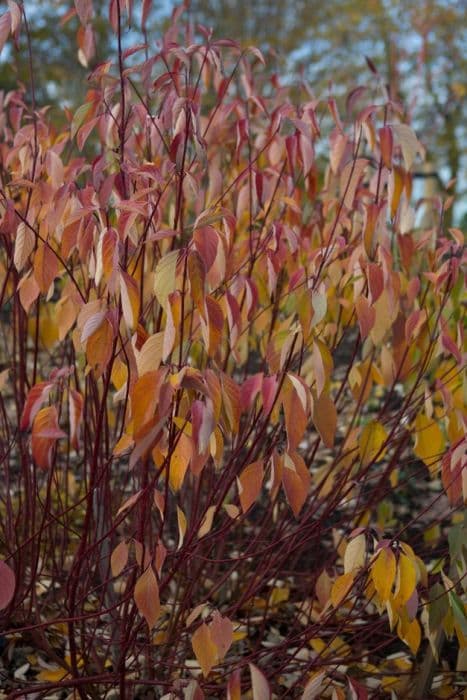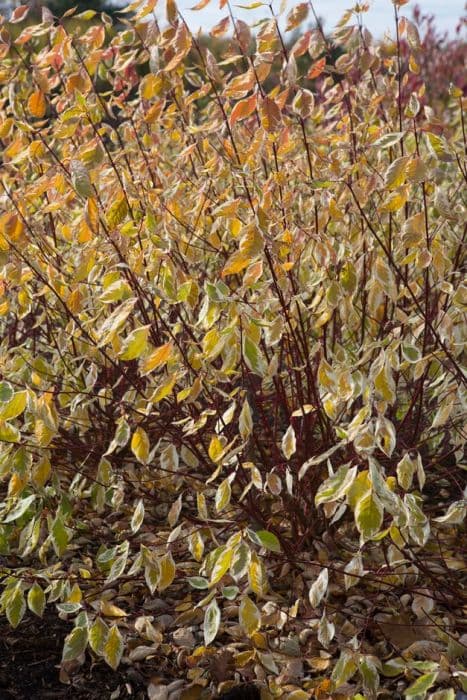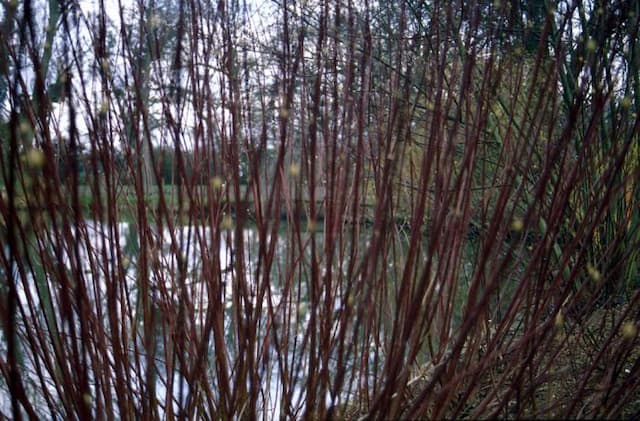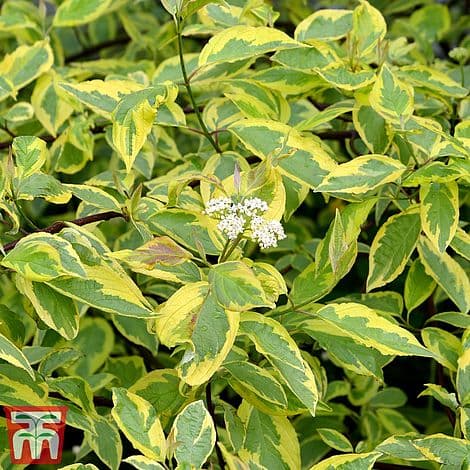Redtwig Dogwood Cornus alba 'Spaethii' (v)

ABOUT
Cornus alba 'Spaethii', commonly known as the variegated red twig dogwood, is a striking deciduous shrub known for its ornamental features throughout the seasons. In spring and summer, the leaves are a variegated mix of green and creamy white, providing a bright and eye-catching contrast. The edges of the leaves are often irregularly margined with the creamy white color, giving it a unique and attractive appearance. As the seasons change, the leaves of the variegated red twig dogwood take on warm hues and may exhibit colors ranging from pink to reddish-purple before they eventually fall off. The standout characteristic for which the shrub is most prized, particularly in the winter months, is its vibrant red stems. These stems offer a bold splash of color against the snowy or barren landscapes of winter gardens. In addition to its foliage and stems, the variegated red twig dogwood produces small white flowers which cluster in flat-topped groupings. These blossoms give way to white or sometimes blue-tinted fruits that can attract birds to the garden. Overall, the appearance of Cornus alba 'Spaethii' brings year-round interest to any garden bed or landscape with its combination of variegated foliage, bright winter stems, delicate flowers, and attractive berries. Its physical characteristics enable it to stand out in the garden and become a focal point for various landscape designs.
About this plant
 Names
NamesFamily
Cornaceae
Synonyms
Spaeth's Redtwig Dogwood, Variegated Tartarian Dogwood, Spaeth's Dogwood
Common names
Cornus alba 'Spaethii'.
 Toxicity
ToxicityTo humans
Red-twig dogwood, which is the common name of Cornus alba 'Spaethii', is not considered toxic to humans. There are no commonly reported symptoms of poisoning for this plant in the literature, indicating that accidental ingestion is not likely to cause harm. However, it is always best to avoid eating parts of ornamental plants due to the potential for idiosyncratic reactions or the presence of garden treatment chemicals.
To pets
Red-twig dogwood, known scientifically as Cornus alba 'Spaethii', usually does not pose a significant toxic risk to pets. It is not listed among the commonly recognized poisonous plants for household animals, and there aren't well-documented cases of pet poisoning from consuming this plant. As with all non-food plants, prudent pet care involves preventing pets from ingesting the plant as a precaution.
 Characteristics
CharacteristicsLife cycle
Perennials
Foliage type
Deciduous
Color of leaves
Variegated
Flower color
White
Height
6-8 feet (1.8-2.4 meters)
Spread
5-6 feet (1.5-1.8 meters)
Plant type
Shrub
Hardiness zones
3-7
Native area
Eastern Asia, Siberia
Benefits
 General Benefits
General Benefits- Aesthetic Appeal: Adds vibrant color to gardens with its variegated leaves, which are green with yellow or white margins, and red stems.
- Seasonal Interest: Offers year-round visual interest with foliage changes throughout the seasons and white flowers in late spring, followed by white or blue-tinted fruit.
- Habitat Support: Provides food for birds and other wildlife with its fruit and serves as a nesting site.
- Soil Erosion Control: Can be used in mass plantings to stabilize soil and prevent erosion, especially on slopes.
- Hardiness: Adaptable to a variety of soil types and conditions; cold-hardy and resilient in challenging climates.
- Low Maintenance: Requires minimal care once established, apart from occasional pruning to maintain shape and encourage bright stem color.
- Diversity: Its unique appearance adds diversity to plantings, contributing to a varied and interesting landscape design.
 Medical Properties
Medical PropertiesThis plant is not used for medical purposes.
 Air-purifying Qualities
Air-purifying QualitiesThis plant is not specifically known for air purifying qualities.
 Other Uses
Other Uses- Cornus alba 'Spaethii' (v), commonly known as Red-barked or Siberian dogwood, can be used in basket weaving due to the flexible nature of its stems.
- These dogwood branches can be used in winter arrangements for their vivid red color, adding aesthetic appeal during the drab season.
- The plant's dense foliage provides excellent cover for birds and other wildlife, offering shelter and nesting opportunities.
- The twigs can be used as natural garden stakes, supporting other plants due to their strength and straight growth.
- The contrasting white-margin leaves can be pressed and used in botanical art projects for their ornamental value.
- During the winter months, the bright stems can be harvested and used as a natural dye for fabrics and crafts.
- The plant can be incorporated into a rain garden design, where it can help filter runoff water and improve soil drainage.
- Young stems can be used in traditional wreath-making for decorations during festive seasons, due to their structural qualities.
- Landscape artists may utilize this dogwood in their designs for its ability to create a colorful hedge or screen when planted en masse.
- Ponds or water features can benefit from the presence of this plant, as it can help prevent soil erosion on banks with its root system.
Interesting Facts
 Feng Shui
Feng ShuiThe Siberian Dogwood is not used in Feng Shui practice.
 Zodiac Sign Compitability
Zodiac Sign CompitabilityThe Siberian Dogwood is not used in astrology practice.
 Plant Symbolism
Plant Symbolism- Purity: The white flowers of Cornus alba, commonly known as Siberian Dogwood, often symbolize purity and innocence.
- Resilience: Being a hardy plant that can withstand cold climates, Siberian Dogwood represents resilience and the ability to endure challenging conditions.
- Energy: The vibrant red stems of the Siberian Dogwood that stand out in winter symbolize a burst of energy or life, especially in the dormant season.
- Protection: In some cultures, dogwoods are thought to offer protection, which may be linked to the tough and sturdy characteristics of these plants.
 Water
WaterThe Siberian Dogwood should be watered deeply, making sure the soil is moist but not waterlogged. During the growing season, water the plant once a week with about 1-2 gallons, depending on the weather conditions—more frequent watering may be needed during hot, dry spells. In winter, reduce watering but do not let the soil dry out completely. Always check the top inch of soil for dryness before watering to avoid overwatering.
 Light
LightFor optimal growth, place the Siberian Dogwood in a location with full sun to partial shade. The plant thrives in a spot that gets at least four hours of direct sunlight daily but remains bright throughout the day. Avoid deep shade positions, as this can reduce the vibrancy of the foliage and the number of flowers.
 Temperature
TemperatureSiberian Dogwood can tolerate a wide range of temperatures, generally from -30 to 85 degrees Fahrenheit. However, this shrub prefers cooler climates and is ideal in zones 2 through 7. The ideal temperature for robust growth and flowering is between 60 to 75 degrees Fahrenheit.
 Pruning
PruningPrune the Siberian Dogwood to maintain shape and encourage bushier growth, typically in late winter or early spring before new growth begins. Remove any dead, damaged, or overcrowded branches to improve air circulation. Every few years, consider rejuvenating pruning by cutting back one-third of the oldest stems to the ground, promoting new growth and ensuring vibrant stem color.
 Cleaning
CleaningAs needed
 Soil
SoilRed Twig Dogwood thrives in moist, well-draining soil with a pH of 5.5 to 7.5. An ideal soil mix should contain two parts loam, one part peat or compost, and one part sand or perlite for improved drainage.
 Repotting
RepottingRed Twig Dogwoods, being shrubs, do not typically require repotting as they are usually planted directly in the ground. If growing in a container, repot every 2-3 years to prevent root crowding.
 Humidity & Misting
Humidity & MistingRed Twig Dogwood prefers average to high humidity levels but is adaptable to various conditions; there is no specific humidity requirement for this hardy shrub.
 Suitable locations
Suitable locationsIndoor
Ensure bright light, cool temps, and moist soil for indoor Red Twig Dogwoods.
Outdoor
Plant in partial shade/sun, keep soil moist, and shelter from harsh winds for outdoor Red Twig Dogwoods.
Hardiness zone
2-7 USDA
 Life cycle
Life cycleCornus alba 'Spaethii', commonly known as Variegated Red Twig Dogwood, begins its life as a seed, which when subjected to appropriate conditions of moisture and temperature, germinates to produce a small seedling with both roots and shoots. As it matures, the plant enters a vegetative growth stage, establishing a root system and producing stems and leaves; the variegated foliage is marked by edges of creamy white against a green center. Once the plant reaches maturity, it enters the reproductive stage, characterized by the production of small white flowers in the late spring to early summer. After pollination, these flowers develop into white-blue berries that serve as a food source for wildlife and culminate the plant's reproductive cycle. During the autumn, the plant's leaves fall, and the stems, which are conspicuously red, providing winter interest. The plant may enter a period of dormancy during the winter months, especially in colder climates, before resuming growth in the spring.
 Propogation
PropogationPropogation time
Late winter-early spring
Propogation: Cornus alba 'Spaethii', commonly known as Variegated Red Twig Dogwood, is often propagated by softwood cuttings taken in late spring or early summer. The most popular method involves cutting healthy, non-flowering shoots of about 6 to 8 inches (15 to 20 centimeters) in length. Each cutting should have several leaves at the top. The lower leaves are removed, and the cut end is dipped in rooting hormone powder to encourage root development. The prepared cuttings are then inserted into a pot filled with a well-draining potting mix, ensuring at least two nodes are buried where roots will form. The pot is then placed in a sheltered location with indirect light and kept moist. Roots typically develop within a few weeks, after which the new plants can eventually be transplanted outdoors.









